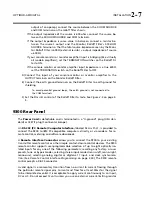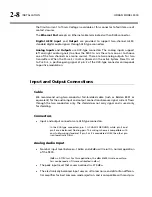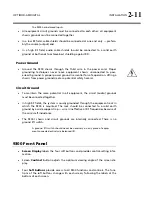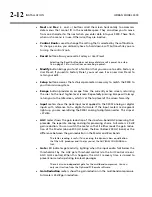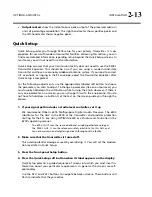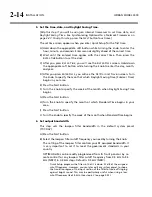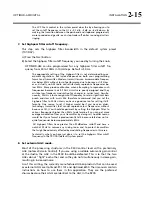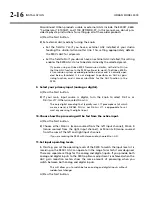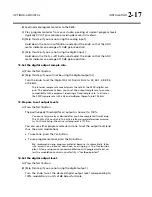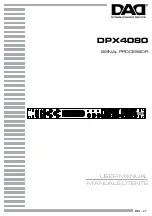
OPTIMOD-AM DIGITAL
INSTALLATION
2-15
The
LPF
S
HAPE
control in the system preset does this by allowing you to
set the cutoff frequency so that it is –0.1 dB, –3 dB, or –6 dB down. By
making the transition between the passband and stopband progressively
more rounded and gentle, each step trades off duller sound against less
ringing.
7.
Set highpass filter cutoff frequency.
This step sets the highpass filter bandwidth in the default system preset
(
TX1/DAY
).
A)
Press the
N
EXT
button.
B)
Select the highpass filter cutoff frequency you need by turning the knob.
OPTIMOD-AM can be programmed for any highpass filter cutoff fre-
quency from 50 to 100Hz in 10Hz steps. Default is 50 Hz.
The appropriate setting of the highpass filter is not determined by gov-
ernment regulations, but instead depends on both your programming
format and transmitter. Modern transmitters can accommodate frequen-
cies below 50Hz without loss of performance due to bounce or tilt. How-
ever, virtually no AM radio can satisfactorily reproduce frequencies be-
low 50Hz. Many produce distortion when attempting to reproduce such
frequencies because their RF AGC circuits are poorly designed and they
mistake low-frequency modulation for changes in carrier level. Simulta-
neously, 50Hz is a low enough cutoff frequency to retain significant bass
punch and slam with music. We therefore recommend that you set the
highpass filter to 50Hz unless you have a good reason for setting it dif-
ferently. One reason to set it higher would be if you have an older-
technology transmitter that cannot reproduce low frequencies without
bounce or tilt. (You should experiment by setting the highpass filter to
various frequencies higher than 50Hz to determine if you can get more
average modulation from your transmitter by doing so.) Another reason
would be if your format is predominantly talk, because talk does not re-
quire frequencies below approximately 80Hz.
All highpass filters have greater than 30dB/octave rolloff and have a
notch at 25Hz to remove any cueing tones and to protect transmitters
that might be adversely affected by modulating frequencies in this area.
Technically, what you have just done is to set the highpass filter cutoff
frequency in the
TX1/DAY
(default) system preset.
8.
Set external AGC mode.
Most of the processing structures in the 9300 control level with a preliminary
AGC (Automatic Gain Control). If you are using a suitable automatic gain control
at the studio, the AGC in the 9300 should be defeated. This is so that the two
AGCs do not “fight” each other and so they do not simultaneously increase gain,
resulting in increased noise.
As of this writing, the currently manufactured Orban products that can be used
as external AGCs are Optimod-PC 1101 and Optimod 6300. Their manuals contain
instructions on how to use them in this application. They are the preferred
choices because their AGCs are identical to the AGC in the 9300.
Summary of Contents for OPTIMOD-AM 9300
Page 1: ...Operating Manual OPTIMOD AM 9300 Digital Audio Processor Version 2 0 Software...
Page 7: ...Operating Manual OPTIMOD AM 9300 Digital Audio Processor Version 2 0 Software...
Page 178: ...3 46 OPERATION ORBAN MODEL 9300...
Page 200: ......
Page 221: ...OPTIMOD AM DIGITAL TECHNICAL DATA 6 21...
Page 222: ...6 22 TECHNICAL DATA ORBAN MODEL 9300 CONTROL BOARD PARTS LOCATOR...
Page 228: ...6 28 TECHNICAL DATA ORBAN MODEL 9300...
Page 229: ...OPTIMOD AM DIGITAL TECHNICAL DATA 6 29 I O DSP BOARD LEFT AND RIGHT ANALOG INPUTS...
Page 230: ...6 30 TECHNICAL DATA ORBAN MODEL 9300 I O DSP BOARD ANALOG OUTPUTS...
Page 231: ...OPTIMOD AM DIGITAL TECHNICAL DATA 6 31...
Page 238: ...6 38 TECHNICAL DATA ORBAN MODEL 9300 FRONT VIEW REAR VIEW FRONT PANEL PARTS LOCATOR DIAGRAM...







